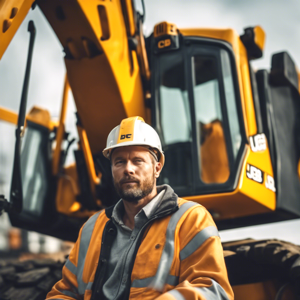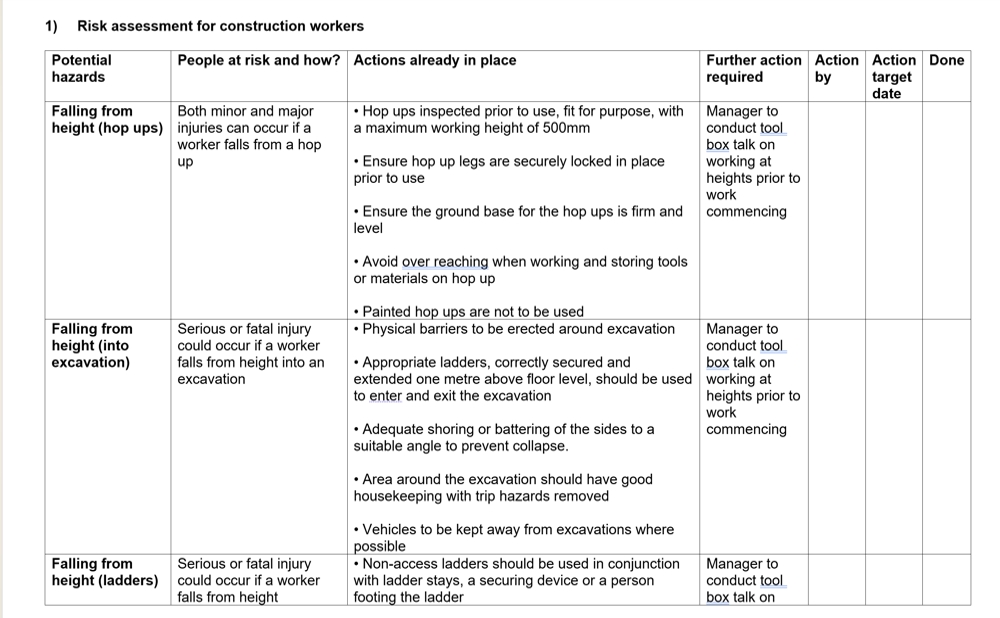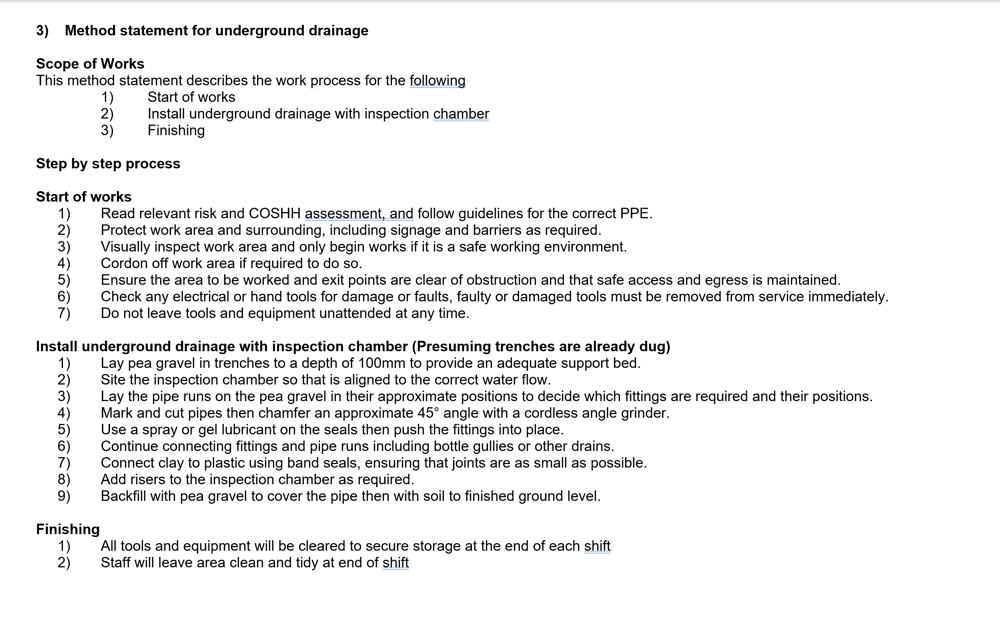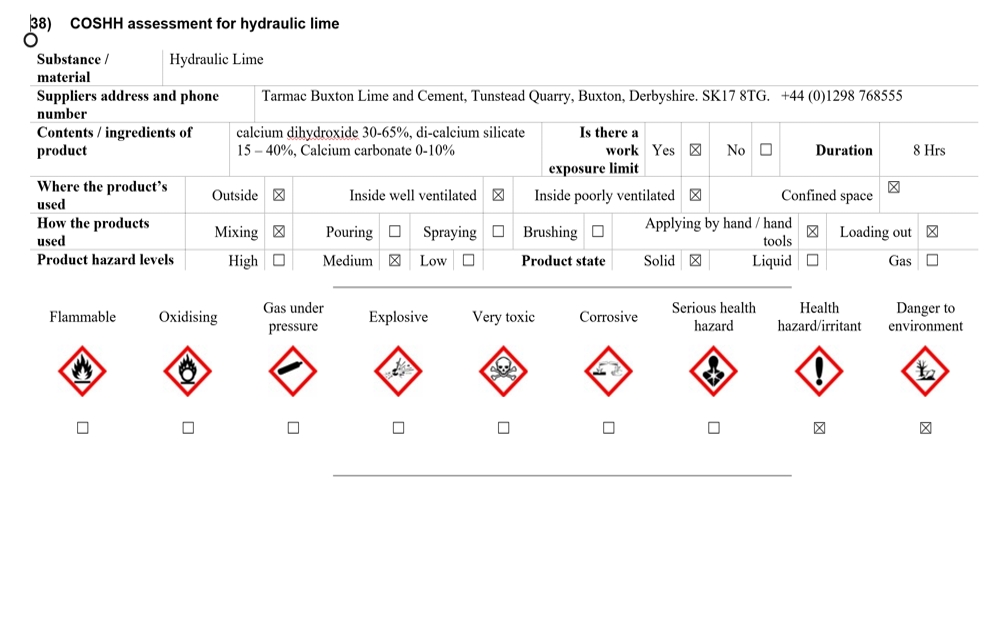Builders health and safety RAMs pack. BEST OFFER

All the RAMS a building company needs in one simple document. A complete health and safety package for just £165.00.
 |
 |
 |
|
Sample 1 |
Sample 2 |
Sample 3 |
Builders play a crucial role in the successful execution of construction projects. They meticulously oversee and coordinate a wide range of activities essential for both commercial and residential properties. Their responsibilities encompass the entire project lifecycle, which may include the construction of new structures and the renovation and repair of existing buildings.
Builders are tasked with the comprehensive planning and management of the construction process. This entails conducting initial site assessments to determine feasibility, coordinating the necessary permits, and developing a detailed project schedule that outlines all construction phases. They meticulously provide cost estimates based on labour, materials, and potential overheads, allowing for budget creation and management that ensures the project remains financially viable.
A critical aspect of a builder’s role is coordinating various subcontractors, such as electricians, plumbers, and HVAC specialists. Builders need to ensure that these professionals are scheduled effectively and that their work is synchronised to maintain a smooth workflow. This coordination is vital to avoiding delays and ensuring all project elements come together seamlessly.
While builders typically oversee most project management tasks, they may also engage in direct construction activities. This could involve the physical labour of laying foundations, framing structures, or installing fixtures and finishes. Their hands-on involvement is sometimes necessary, especially in smaller projects, where they may take on a more versatile role.
Builders are also adept at handling repairs and renovations, which require a keen understanding of structural integrity and compliance with building codes. They strive to ensure that all upgrades maintain or enhance the quality and aesthetic of existing buildings, working closely with clients to understand their vision and requirements.
Builders frequently conduct pre-construction safety audits before the commencement of construction. These assessments evaluate site conditions and are critical for identifying potential hazards. Builders implement safety protocols to safeguard the well-being of all workers on site, thereby fostering a culture of safety and compliance throughout the project’s duration.
Throughout the construction process, builders oversee the quality of all work performed. They ensure that it adheres to industry standards and meets clients' expectations. This may involve regular site inspections and evaluating completed tasks to guarantee that workmanship, materials, and finishes align with established guidelines.
Builders must be agile problem-solvers, equipped to troubleshoot and resolve issues that may arise during construction. This could range from addressing unexpected site conditions to managing disputes among subcontractors. Their ability to remain calm under pressure and provide quick solutions is essential for keeping projects on track.
Table of contents for construction package
Risk assessments for:
- 01) Construction workers
- 02) Risk awareness for areas where asbestos could potentially be discovered
Method statements for:
- 03) Underground drainage
- 04) Underpinning
- 05) Brick and blockwork
- 06) Cleaning brickwork
- 07) pointing and repointing
- 08) Block paving
- 09) Laying slabs
- 10) Fencing
- 11) Hedge cutting, strimming and lawn works
- 12) General plumbing works, pipe connections, transport and storage
- 13) Removing a bathroom suite
- 14) Fitting a bathroom suite
- 15) Power flushing
- 16) Maintenance and service of central heating system
- 17) Connection to a gas main
- 18) Rainwater goods
- 19) Rewires, maintenance and new installations
- 20) Hanging wallpaper
- 21) Painting
- 22) Boarding and skimming
- 23) Bonding and skimming
- 24) Rendering
- 25) Recommended fixing techniques into various sub structures
- 26) Roof timbers
- 27) Hanging doors
- 28) Kitchen fitting
- 29) Laminate flooring
- 30) Timber partitioning
- 31) UPVC doors
- 32) UPVC soffits and fascia
- 33) UPVC windows
COSHH assessments for:
- 34) Cement
- 35) Brick and patio cleaner - Acid
- 36) Brick and patio cleaner - Eco
- 37) Hydrated lime
- 38) Hydraulic lime
- 39) Mortar plasticiser
- 40) Mortar water proofer
- 41) Petrol
- 42) Fernox central heating cleaner
- 43) Lead free solder
- 44) Lead solder
- 45) Silicone sealant
- 46) Flux paste
- 47) Solvent cement
- 48) Decorator’s caulk
- 49) Dust
- 50) Expanding foam
- 51) Expanding foam (fire rated)
Our comprehensive package of builders' health and safety documents is truly remarkable—it includes a whopping 51 different documents covering a wide range of topics, all based on our extensive professional experience and our analysis of customer download trends. Each document has been carefully crafted to ensure that builders can work in a safe and secure environment, and the package has been compiled for your convenience in an easy-to-use format. You can access all of these resources instantly as an electronic download.
This comprehensive package is designed to help your company succeed quickly. Along with a wide range of professional services, it also includes the prestigious "Health & Safety Gold Standard Award". With this award, you can demonstrate to your clients that your business is deeply committed to ensuring their health and safety. Don't miss this opportunity to take your company to the next level! Act now and get started on the path to success.
When you navigate to the index of contents, you'll witness the numerous benefits of our builder's H&S package. It has been proven to be highly effective and has helped many companies win contracts and become approved suppliers. Don't miss out on this opportunity to elevate your business—get the RAMS package today.
The package in question is incredibly user-friendly and requires minimal effort to utilise. It features a single cover page where you can input your company's details, sign and date the document, and it's ready to go. The best part is that it is straightforward to use. The document comes in a docx format, which can be opened with Word™ or any other word processor, and is fully editable. This means that you can easily customise it to your liking by adding your company logo and incorporating bespoke borders, backgrounds, or colour schemes as per your requirements.
If you're looking for a customised set of health and safety documents for your company, hiring a professional to create a bespoke solution can be costly, with rates ranging from £45 to £60 per hour. However, our builder's H&S package offers a cost-effective solution. With 51 bespoke documents included, purchasing this package saves you £300 compared to buying each document individually. Not only that, but this package is yours to keep for life, and we offer free updates to the documents whenever necessary due to changes in health and safety regulations. All you have to do is log in to your account and download the latest version of the document. This package's positive value is truly fantastic, making it an excellent investment for any business looking to maintain a safe and compliant workplace.
Not only is this document great value for money, but it’s also great quality and is:
- Recognised by local authorities.
- Recognised by principal contractors.
- Suitable for CDM sites.
- Approved by H&S managers.
Our package is more than just a collection of documents. It’s a comprehensive professional H&S solution specifically tailored for building companies. With this package, you can feel secure in your H&S management, knowing that all your needs are covered.
Risk is an unavoidable part of life, whether at work or outside. In any hospital, the Accident and Emergency department is constantly buzzing, regardless of the time of day, as individuals seek medical attention for injuries resulting from a fall or any other mishap.
The construction industry is inherently dangerous, and it is reported that over 50,000 injuries occur each year, with an average of 30 fatalities. These are not just minor incidents, but often life-altering events. It is important to keep in mind that the accident rate is much higher than the injury rate since not all accidents cause injuries. Furthermore, minor injuries like bruises or paper cuts often go unreported. It is also valuable to consider the number of accidents that are prevented due to the current health and safety measures in place.
Falls from height account for approximately half of all fatalities and a break down of the 50,000 non-fatal injuries are:
- Slips, trips and falls on the same level account for 25%.
- Falls from height account for 18%<./li>
- Manual handling injuries make up 20%.
- Being struck by a moving or flying object is 10%.
Despite the presence of current health and safety measures, the frequency of injuries in the construction industry remains alarmingly high, exceeding a thousand per week. This stark reality underscores the critical importance of your company's health and safety documents. Each one of you plays a crucial role in preventing these accidents, and it's in your hands to make a difference.
The construction industry is known for being fraught with risks and hazards that pose a significant threat to the safety and well-being of workers and anyone else affected by the work. To combat this, various acts and regulations have been implemented to safeguard against such risks. However, building companies are also responsible for ensuring the safety of their employees and others their operations may impact. Health and Safety (H&S) documents come into play, outlining how the company intends to manage, reduce, or protect against such risks.
Building companies must implement safe working practices to manage risks effectively. These practices are documented in risk assessments and method statements. A risk assessment is a comprehensive document that assesses the risks involved in a specific task, outlining potential hazards and the likelihood of harm. Once the risks have been identified, control measures are put in place to limit or control them.
By adhering to these regulations and implementing their own H&S measures, construction companies can ensure the safety of their workers and others while also minimising the risk of accidents and injuries.
In certain situations, a large truck reversing can pose a significant safety risk to nearby individuals. To ensure the safety of everyone involved, it is crucial to implement appropriate control measures. Ideally, the best way to mitigate this risk would be to stop the truck from reversing altogether. However, this is not always feasible. In such cases, other measures can be taken to minimise the risk. One such measure is to install a rearview camera that allows the driver to see what's behind the truck while reversing. Additionally, an audible warning system can be implemented to alert pedestrians and other drivers of the truck's movements. By implementing these control measures, safe working practices can be established when reversing the car, thereby ensuring the safety of everyone involved.
When a driver is about to reverse a vehicle on a specific work site, an accompanying method statement can provide them with valuable information. This statement could include details about the site's traffic management plans and instructions regarding the use of cameras and audible warnings, which must be in working order before reversing the vehicle. Additionally, the method statement may outline what to do in case the control measures fail and suggest that a banksman be employed to assist with manoeuvring the vehicle.
A building company's H&S documents should also include a company health and safety policy and COSHH assessments that show how to deal with substances that are hazardous to health.
This H&S package for builders covers most of the documentation you will need but doesn’t include a company health and safety policy; by law, this must be a separate document.
Other documents that builders might be asked to provide include Insurance, training records, lone worker policies, anti-slavery policies and more.
A construction company must establish well-documented health and safety procedures. However, the mere existence of these documents does not ensure job site safety. It's crucial to communicate the information in these documents to the workers effectively. For instance, if the management team deems it unsafe to work under scaffolding without a hardhat but neglects to inform the staff and doesn't enforce this rule, the documentation loses its purpose. In this scenario, the safety protocols become a formality, failing to contribute to a safer work environment and potentially leading to severe consequences.
Merely checking boxes on a checklist might create a false sense of security, but it doesn't guarantee safety. To effectively mitigate risks and prevent accidents, it's essential to provide workers with comprehensive education, instruction, and training. This includes teaching them how to perform their tasks safely and the potential hazards of not following proper safety protocols. This proactive approach is the key to ensuring a safe working environment for all.
The HSE states that employees must be instructed on safe working practices for many tasks, and due to the accident rate in the construction industry, four areas of training that many consider mandatory are:
- Slips, trips and falls.
- Working at height.
- Manual handling.
- Asbestos awareness.
Training in the above topics is usually done through online courses.
GET THIS DOCUMENT
£165.00+VAT
- Available in Word™
- Fully customisable
- Add your Company Logo
- UK & EU Compliant

 CART
CART 